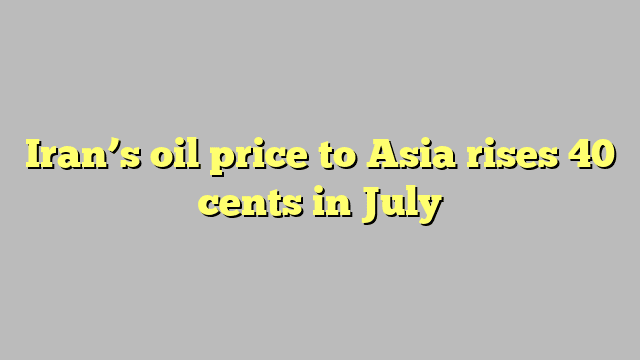The price of Iranian oil destined for Asia is scheduled to rise, during next July, by about 40 cents compared to the current month of June, at a value that is 5 cents lower than the prices of Saudi Aramco shipments during the next month.
And the National Iranian Oil Company announced the official selling prices for July shipments to its customers in the Asian, Middle Eastern and European markets, according to a price document seen by the specialized energy platform.
The company raised the price of Iranian light oil in July by about $0.4, at $3 above the Amman/Dubai average, compared to shipments this June, which were only $2.6.
The price of Iranian heavy crude destined for Asia rose by about $0.4 to $1.05 above the Dubai/Oman average over the next month, compared to June shipments, which were $0.65 above the Dubai average.
And the Iranian Oil Company decided to increase the prices of Forouzan crude shipments to Asia during July by the same value, to record $ 0.95 above the average Dubai / Oman crude, compared to $ 0.55 in this June, according to a pricing document seen by the specialized energy platform.

Iran oil price in july
The National Oil Company in Tehran has informed its clients in Europe, the Middle East and Africa of raising Iranian oil prices next July.
It is scheduled that shipments of Iranian light crude will be recorded around 1.35 and 6. 0 and 1.35 dollars above the average for Brent crude for the three markets, respectively, an increase of 0.9 and 0.6 dollars, compared to 0.45, 0 and 0.45 dollars above the average for Brent crude in June.
Tehran decided to raise the selling price of heavy crude oil by about 90 cents to European markets at $0.20 below average Brent crude, 50 cents to the Middle East at $1.10 below average Brent, and 90 cents to Africa at $0.20 below average Brent crude, compared to prices. June shipments to European markets were $1.10 below average Brent, the Middle East at $1.60 below average Brent, and Africa at $1.10 below average Brent.
The Iranian Oil Company announced an increase in the price of Forouzan crude shipments in July, about $0.9 to Europe and Africa, to $0.30 below average Brent crude, compared to $1.20 below Brent crude in June.
Saudi Aramco prices
Early this month, Saudi Aramco announced the official prices for selling shipments of Arab Light crude to its customers in Asia, Europe and the United States, during next July (2023).
The company raised Saudi Arabia’s official selling prices for Arab Light crude to Asia by 45 US cents to $3 per barrel, above the Oman/Dubai average, according to the pricing document seen by the specialized energy platform.
The decisions to raise prices by Riyadh, Tehran and the countries of the Middle East come after expectations of a shortage of supplies in the markets during the next month, after Saudi Arabia pledged to provide an additional production cut by one million barrels per day next July.

demand for Iranian oil
This comes amid a report indicating that Iranian oil exports have risen to the highest level in 5 years, as Tehran’s supplies doubled in May to 1.6 million barrels per day, despite the continuation of US sanctions.
Production reached 2.9 million barrels per day, which is the highest level since late 2018, according to estimates by the International Energy Agency, which is based in Paris.
Forecasts of the International Energy Agency’s forecasts indicate that global oil markets are set to turn into a large deficit during the remainder of the current year, with the acceleration of China’s recovery in the wake of the Corona epidemic.
It is also expected that demand will exceed the existing supply by about two million barrels per day during the second half of 2023, which will be sufficient to absorb additional Iranian flows.

Leave a Reply